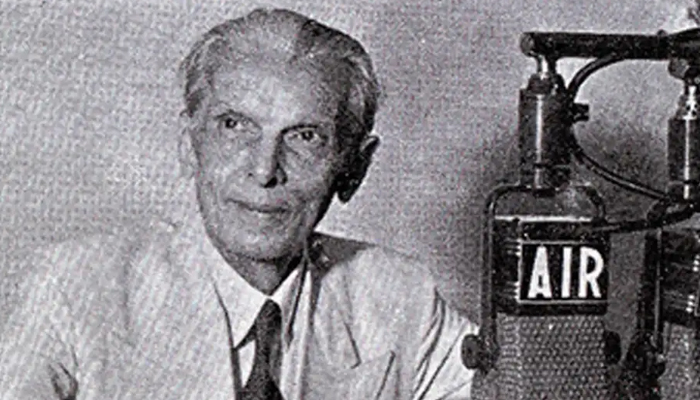Jinnah’s vision for a welfare state
Pakistan is currently grappling with its worst economic crisis, marked by a staggering 40% inflation that, although reduced to 30%, remains alarmingly high. In recent months, the Pakistani rupee has experienced a significant depreciation against the US dollar, now trading at approximately PKR 288 in the open market. The economic situation has never been as grim as we witnessed recently, marked by all-time high inflation. The prices of commodities have quadrupled in the last two years, while income has shrunk. In addressing the needs of individuals with limited economic opportunities, what responsibilities does the state bear to foster inclusive growth? Furthermore, as a long-term strategy to rectify this unfair distribution of resources, could the concept of a welfare state be a viable solution?
Can we connect today’s problems with the economic concept of Pakistan by Quaid-i-Azam? Yes, we can.
On the day of the birth of Mohammad Ali Jinnah, as we reflect on how he envisioned the economic health of Pakistan, we may begin with his concept of economic equality and a welfare state, which served as a cornerstone of his economic ideology for Pakistan. Quaid-i-Azam was consistently concerned about the economic growth of Muslims since 1909, advocating for their economic emancipation and the growth of businesses and enterprises for the overall well-being of society. At a public meeting in 1948, Quaid-i-Azam stated,
“The great ideals of human progress, of social justice, of equality and of fraternity constitute the basic causes of the birth of Pakistan....”.
Quaid-i-Azam’s concern for the welfare state was as intense as his political ideas, dating back to 1909. He wasn’t solely focused on political rights but also on the economic survival of Pakistan. The foundation of his vision for the welfare state rested on an economic roadmap that aimed to prevent the exploitation of the poor masses by capitalists. Upon delving into the literature, it becomes evident that despite receiving his higher education in Europe, he realised that replicating the Western welfare model wouldn’t work for Pakistan, given its critical situation. The entire economic structure, including the industry, had to be built from scratch. He envisioned an economic model calling for substantial structural changes in agriculture, industrial growth, and resource equity, with a pragmatic approach. The idea was that a backward economy could complement a modern one, leading to a more equitable distribution of wealth. Interestingly, the core essence of today’s modern international institutions aligned precisely with what Quaid explained in the 1940s - the generation of full employment opportunities through an inclusive approach and the development of a competitive, labour-intensive industry for Pakistan.
He envisioned institutional development, recognising that the production and distribution of resources hinge on the institutional quality of the country. Measures need to be taken to protect the poor, and this is where the Western welfare state diverges, reflecting its unique history and the development of institutions for resource distribution.
Ironically, for decades, we have forgotten the principle of social welfare and remained disconnected from the idea of the just distribution of resources. Historically, welfare policies in Pakistan have been very fragmented, and even when they existed, their effectiveness was hindered by poor policy implementation.
Quaid-i-Azam was not a professional economist, yet he grasped the fundamental role of the state in adopting an inclusive approach to development. His concept of a welfare state emerged when he established the Economic Planning Committee in 1943, tasked with creating a roadmap and blueprint for industrialisation, education, agriculture, and the reduction of income inequality over the next 20 years. This is where the Quaid stands out as a leader in the establishment of a welfare state. After independence, on numerous occasions, the Quaid emphasised the importance of Human Capital Development in trade, industry, education, and agriculture, which could serve as the strength of human resources and productivity in Pakistan. He encouraged enterprises for the sake of industrial growth, with the central role of the state being policy intervention and public facilitation. He acknowledged the significance of research and its linkage with the development in the industrial sector. When we examine our industrial development policy in this context, we observe a focus on developing individual firms rather than sectors, neglecting the creation of a strong industrial foundation targeted for preferential treatment and sectoral growth. The current state of Pakistan’s cash-strapped economy and the burden on the poor masses reveals the extent to which resources have been extracted by industrialists, traders, and individuals due to special incentives and privileges. While this is not the sole factor contributing to the lack of growth, the most deeply rooted causes lie in the economic structure and institutions that allow elite capture without providing a fair chance for broader development.
Contrary to the welfare model, we have developed a rent-seeking economy, with the economic structure favouring elitist interests rather than addressing the needs of the underprivileged. This stands in contrast to the principle of justice and equality envisioned by the Quaid.
According to his vision, the provision of basic services such as education, health, and social protection was fundamentally the responsibility of the state. This approach could have helped built a just society with an inclusive growth perspective, a vision we missed, even during the trickledown effect strategy of Pakistan in the 1960s economic policy. The stop-go policy also failed to benefit the middle and poor classes of this country. There has been an incoherent industrial policy in Pakistan. The policies of the 1950s focused on agri-based industries, followed by import substitution and private sector-led growth in the 1960s aimed at a trickledown effect. The 1970s witnessed a nationalisation policy, while the 1980s saw public-led private investment. The 1990s marked the privatization of public sector entities with a shift towards liberal economic policies, and the trend continued into the 2000s with a privatisation and investment regime. This indicates a lack of coherence in the implementation of industrial policies in Pakistan.
All these developments have led to elite capture in Pakistan. From a political-economic perspective, these developments reveal that elite and political capture exists in all productive sectors, agriculture, industrial, and trade, which hinders the rational distribution and redistribution of resources. This goes against the welfare blueprint envisioned by the Quaid. Examining the development of industrial policies in Pakistan, it becomes apparent that the country could not sustain the pace of its industrial development trajectory since the 1960s. However, some progress was made in import-substituting industrialisation, and industrial strategies evolved into a more coherent policy in the sixties under General Ayub’s regime. Industrial credit was subsidised, and its allocation was controlled by the state through two publicly-owned industrial banks. Simultaneously, enterprises were established in the public sector and later divested as running ventures to the private sector. Incentives were provided to exporters through an innovative ‘Bonus Voucher’ scheme to promote exports.
However, such reforms were criticised for their exclusionary approach.
In the 1970s, through the Economic Reforms Order of 1972, the government took control of ten major industries, including iron and steel, motor vehicle manufacturing, cement, and utilities like gas and oil refineries. The consequence was a decline in the competitiveness of the private sector. As a result, public investment increased, but private sector investment gradually decreased.
This is how the leading role in industrialisation shifted from the private sector to the government, whereas Quaid emphasised an increasing role for the private sector in the economic growth. Furthermore, we observe an extended role of bureaucracy in both policy-making and implementation. This has positioned bureaucracy at the center of affairs, seeking control over productive units.
“The 1990s was the decade of market-oriented programs, in line with various IMF programs during the 1980s and 1990s. Pakistan became a member of the World Trade Organisation (WTO) on January 1, 2005, and integrating the textile and clothing sectors posed a challenge. Due to high protectionism in the domestic industrial sector of Pakistan, it shielded itself from foreign investments, leading to limited competition. As a result, Pakistan remained focused on a small number of agriculture-based, non-value-added products.”
“Moreover, the trade policy tends to favour businesses and industries usually associated with or owned by individuals holding titles as policy makers in the legislature or having connections to powerful lobbying for political capital. This aligns with the feature of the political economy of Pakistan, as termed by Hamza Alvi, who suggests that Pakistan is an overdeveloped state due to the disproportionate growth of its civil and military bureaucracy. This results in considerable discretionary trade protection created through powerful lobbying. Consequently, we are clearly disconnected from Quaid’s idea of the just distribution of resources and inclusive growth. Although he was part of the power corridor in Pakistan, one tends to agree with Mifta Ismail’s observation that ‘Pakistan’s economy thus only relies on whatever a small elite can achieve. It remains underdeveloped as it ignores the talent of most in the country.’”
The above discussion highlights an interesting paradox in Pakistan’s economic development. One might conclude that Pakistan has chosen underdevelopment, despite having all the necessary elements to build a social welfare economy, as envisioned by Quaid-i-Azam. While Pakistan has various economic visions and strategies, have we ever positioned ourselves as policy planners to scrutinise Jinnah’s economic vision?”
-The author is a political economist and the winner of prestigious Martin Luther King Award
-
 First Poll Since King Charles' Action Against Andrew Reveals Royal Family's Public Standing
First Poll Since King Charles' Action Against Andrew Reveals Royal Family's Public Standing -
 Blake Lively Strengthens Legal Team Ahead Of Justin Baldoni Trial
Blake Lively Strengthens Legal Team Ahead Of Justin Baldoni Trial -
 'Back To School!': Palace Shares Details Of Princess Anne's Latest Engagements
'Back To School!': Palace Shares Details Of Princess Anne's Latest Engagements -
 Paul Mescal Clarifies Acting Break Comment As He Teases Paul McCartney Role
Paul Mescal Clarifies Acting Break Comment As He Teases Paul McCartney Role -
 Kate Middleton's Unexpected Style Of Arrival At Solo Outing Goes Viral
Kate Middleton's Unexpected Style Of Arrival At Solo Outing Goes Viral -
 Why ‘X’ Is Down? Thousands Report Twitter Outage: Here’s What You Can Do
Why ‘X’ Is Down? Thousands Report Twitter Outage: Here’s What You Can Do -
 Florida Man Held After Alleged Nail-scattering On Busy Intersections
Florida Man Held After Alleged Nail-scattering On Busy Intersections -
 Valeria Nicov: Sean Penn's Athletic Girlfriend Raises Eyebrows With Latest Photos
Valeria Nicov: Sean Penn's Athletic Girlfriend Raises Eyebrows With Latest Photos -
 Sharon Stone Lashes Out At Fellow Award Show Attendees After Stealing Accusations
Sharon Stone Lashes Out At Fellow Award Show Attendees After Stealing Accusations -
 Gwyneth Paltrow Reveals Real Reason She Said Yes To 'Marty Supreme'
Gwyneth Paltrow Reveals Real Reason She Said Yes To 'Marty Supreme' -
 King Charles Says He And Queen Camilla Stand With People Of Ukraine
King Charles Says He And Queen Camilla Stand With People Of Ukraine -
 Ben Affleck Argues In Favour Of His Shirtless Scene In 'The Rip'
Ben Affleck Argues In Favour Of His Shirtless Scene In 'The Rip' -
 Mississippi Postal Worker Arrested After Complaints Of Marijuana Odour In Letters
Mississippi Postal Worker Arrested After Complaints Of Marijuana Odour In Letters -
 Canada, China Lock Initial Trade Deal On ‘EV,Canola’ To Strengthen Ties: What To Expect Next?
Canada, China Lock Initial Trade Deal On ‘EV,Canola’ To Strengthen Ties: What To Expect Next? -
 Melissa Leo On Euphoria Of Winning An Oscar Vs It's Impact On Career
Melissa Leo On Euphoria Of Winning An Oscar Vs It's Impact On Career -
 Meghan Markle, Prince Harry Express 'hope' In Latest Major Statement
Meghan Markle, Prince Harry Express 'hope' In Latest Major Statement




